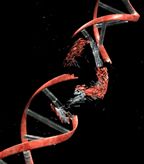Genomics Studies Identify Testicular Cancer Risk Variants
Two genome-wide studies have identified a total of 12 new genetic loci associated with a higher risk of testicular cancer. The risk-associated genetic variations could help clinicians single out higher-risk men for screening and early detection.
Two genome-wide studies have identified a total of 12 new genetic loci associated with a higher risk of testicular cancer. The risk-associated genetic variations could help clinicians single out higher-risk men for screening and early detection. Five risk loci were previously known, bringing the total number of loci associated with testicular cancer risk to 17. The studies were published in Nature Genetics.

Testicular cancer-specifically testicular germ cell tumor (TGCT)-is currently the most frequently diagnosed cancer among men aged 15 to 45, with peak diagnosis in men aged 25 to 34. Although not common, the rates of men of European ancestry in the United States diagnosed with testicular cancer have doubled over the past 30 years. According to the National Cancer Institute, approximately 7,920 men will be diagnosed with the cancer this year. Genetic factors are estimated to account for as much as 25% of susceptibility to testicular germ cell tumors. Other risk factors previously identified include a family member with the disease, cryptorchidism, height as an adult, and prior history of testicular cancer. Marijuana use may also play a role in risk of the cancer.
In one study, Clare Turnbull of the Institute of Cancer Research in Sutton, London, and colleagues used a meta-analysis of genome-wide association data to isolate novel genetic variants, analyzing 1,064 cases of testicular cancer and 10,082 controls. The team identified nine new susceptibility loci for testicular cancer. One genetic locus was in common between the two studies. Several of the loci are near genes involved in male germ cell development, such as PRDM14. One of the loci contained the gene PITX1, known to regulate the expression of the catalytic subunit of telomerase, the enzyme that adds telomere sequences onto the ends of chromosomes. This telomere regulating locus is the third such locus associated with TGCT risk, according to the researchers.
Integrating of these genetic variants with known environmental and development risk factors could lead to “clinically useful risk profiling for TGCT in unaffected men, which in turn may provide a rational basis for applying strategies for the screening and targeted prevention of TGCT,” wrote Turnbull and colleagues.
In another study, a team led by the Perelman School of Medicine at the University of Pennsylvania conducted a meta-analysis of three genome-wide association analysis databases. Author Katherine L. Nathanson, MD, department of medicine, translational medicine, and human genetics, Perelman School of Medicine, and colleagues analyzed 931 men with testicular cancer and 1,975 controls, identifying four novel loci associated with testicular cancer risk-HPGDS, MAD1L1, and RFWD3, as well as a locus that includes the TEX14, RAD51C, and PPM1E genes. To confirm these results, the team then analyzed an additional 3,211 men with testicular cancer and 7,591 controls.
Each of the loci identified are within genes that very well could be candidate genes for conferring an increased risk of testicular cancer, according to the researchers. For example, the genes HPGDS, RAD51C, and TEX14 function in the male germ cell development pathways. Disrupting male germ cell development has been shown previously to lead to tumor initiation, as well as infertility. TEX14 and MAD1L1 have roles in chromosomal segregation. Except for RAD51C, which has been associated with a risk of ovarian cancer, none of these loci have been implicated in susceptibility to other cancers.
“What is striking is that many of the loci identified contain genes with clear biological plausibility, and are implicated in the development of male germ cells,” said Nathanson. “This also provides a partial explanation for the link between TGCT and infertility.”
Both studies found that many of the genetic variants are in close proximity to genes that function in male germ cell development. This is consistent with testicular cancer arising from primordial germ cells in the testes, making it a relatively homogenous disease group compared with other cancer types.
The chance of a patient having testicular cancer and also expressing a specific genetic variant compared with the chance of having testicular cancer given genetic variant is called the odds ratio and is calculated for all loci identified in genome-wide association studies. “If you look at GWAS studies in other cancers, such as breast or prostate, the highest odds ratio identified was 1.2, and they quickly drop off from there,” Nathanson said. But despite identifying 17 loci, the odds ratios for these testicular cancer susceptibility loci are higher, in the 1.2 to 1.3 range. “The odds ratios are likely higher because it is a more homogenous disease group, with a larger genetic component,” said Nathanson.